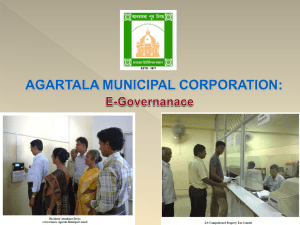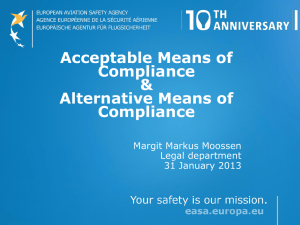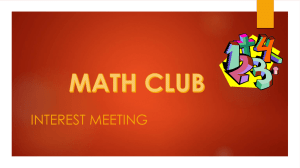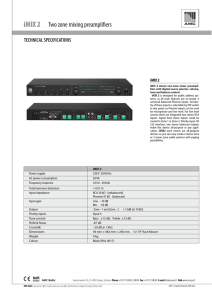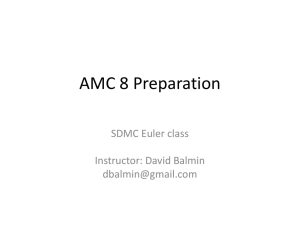PowerPoint
advertisement
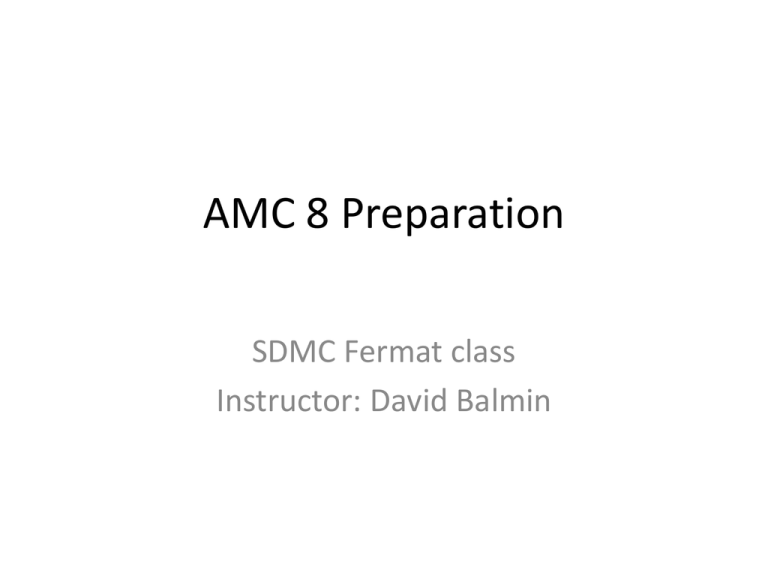
AMC 8 Preparation SDMC Fermat class Instructor: David Balmin Introduction • No calculators are allowed at AMC tests. • Approximately 10 first problems of each AMC 8 test can be solved without using pencil and paper. Introduction • Visit http://amc.maa.org: • “AMC Archives” –> “AMC 8” –> “Brochure Sample Questions” • Publications -> “AMC 8 Math Club Package 2009” with the large collection of AMC problems and solutions. Introduction • Practice to answer questions 1 through 15 of each test. • Try to solve these problems as fast as you can. • If you can quickly answer questions 1 through 15 correctly, concentrate on solving problems 16 through 25. Focus • We will focus in this class on solving several selected AMC 8 problems that are instructive and cover different topics. • We will start with reviewing some math theory and methods that can help you solve AMC 8 test problems. Triangles Triangles Triangle Inequality Theorem Equilateral and Isosceles Triangles Right Triangles Right Triangles AMC 8 2005, Problem #9 AMC 8 2005, Problem #9 • Triangle ACD is isosceles. • Therefore, angles ACD and ADC have equal measures. • Triangle ACD is equilateral (60-60-60). • The length of AC = 17. • Answer (D). AMC 8 2005, Problem #9 • Note: information that sides AB and BC both have length 10 is irrelevant and is not used in the solution of this problem. AMC 8 2005, Problem #13 AMC 8 2005, Problem #13 • Draw the rectangle FEDG in the lower left corner of polygon FEDCEF. • The area of rectangle ABCG is 9*8 = 72. • The area of rectangle FEDG is 72 – 52 = 20. AMC 8 2005, Problem #13 • • • • • DE = FG = 9 -5 = 4. EF*4 = 20. EF = 5. DE + EF = 4 + 5 = 9. Answer: (C). AMC 8 2005, Problem #23 AMC 8 2005, Problem #23 • Draw full square ADBC and full circle inscribed in this square. • The area of the circle is 2*Pi * 2 = 4*Pi. • Then, the radius of the circle is 2. • Then, the side of square ADBC has length 4. • The area of square ADBC is 16. • The area of triangle ABC is 8. • Answer: (B). Perimeter of a Triangle Triangle ABC has side-lengths AB = 12, BC = 24, and AC = 18. Line segments BO and CO are bisectors of angles B and C of ∆ABC. Line segment MN goes through point O and is parallel to BC. What is the perimeter of ∆AMN? (A) 27 (B) 30 (C) 33 (D) 36 (E) 42 Perimeter of a Triangle Perimeter of a Triangle • Hint: The alternate interior angles between two parallel lines and a transversal line have equal measures. • So, ∠MOB = ∠OBC. • So, ∠MOB = ∠MBO. Perimeter of a Triangle • So, triangle OMB is isosceles. • MB = MO. • For the same reason, NC = NO. Perimeter of a Triangle • The perimeter of ∆AMN is: AM + AN + MN = AM + AN + MO + ON = = AB + AC = = 12 + 18 = 30. Answer: (B) Perimeter of a Triangle • Note: the point of intersection of angle bisectors of a triangle is the “incenter” of that triangle. • Incenter is the center of the inscribed circle. Eratosthenes Eratosthenes • Circa 200 BC, the Greek mathematician Eratosthenes invented the brilliant method of measuring the circumference of Earth, based on his knowledge of geometry and astronomy. • His method is a good example of finding the “smart way” instead of the “hard way” to solve a difficult problem. Eratosthenes • As shown in the diagram, he needed to measure the angle φ between the two radii of the Earth pointing to the cities Alexandria and Syene in Egypt. Eratosthenes Eratosthenes • The direct (hard) way would have been to measure angle φ from the center of the Earth. • But the smart way that Eratosthenes invented was to measure the same angle φ between the sun ray and the lighthouse in Alexandria at noon time on the day of summer solstice, when the Sun was at the zenith in Syene. Eratosthenes • Using geometry of parallel lines, he calculated that the distance from Alexandria to Syene must be ≈ 7/360 of the total circumference of the Earth. Eratosthenes • The measurement of the distance between Alexandria and Syene was based on the estimated average speed of a caravan of camels that traveled this distance. • It is generally believed that Eratosthenes' value corresponds to between 39,690 km and 46,620 km., which is now measured at 40,008 km. Eratosthenes result is surprisingly accurate. Geometry on a Grid Problem • Assuming that the grids in both diagrams consist of straight lines that form squares of the same size, how can it be explained that the second figure has a hole? Geometry on a Grid Problem Geometry on a Grid Problem • The composition of two hexagons in the first figure forms a rectangle with dimensions 5x3 = 15. • The composition of the same two hexagons in the second figure forms a rectangle with dimensions 8x2 = 16. • 16 – 15 = 1 explains the extra square. Geometry on a Grid Problem • The combined figures in the diagrams look like triangles, but they are not! • They are quadrilaterals. • Count squares along each horizontal and vertical side of all four parts inside each figure. Geometry on a Grid Problem • All four geometrical shapes (except one extra square in the second figure) have the same dimensions in both diagrams. • It proves that the combined figures cannot be triangles. Otherwise, their areas would be equal which would make the existence of an extra square inside one of them impossible. Probability • • • • • Experiment Outcomes – Sample space Probability of the desired event: P The number of all possible outcomes: N The number of distinct ways (outcomes) the desired event can occur: M • P=M/N Probability – Example 1 • • • • Experiment: tossing a coin. All possible outcomes: heads or tails. The desired event: a coin landing on heads. Probability of the desired event: 1/2. Probability – Example 2 • • • • Experiment: throwing a dice with 6 faces. All possible outcomes: numbers 1 through 6. The desired event: an odd number. Probability of the desired event: 3/6 = 1/2. Probability – Example 3 Probability – Example 3 • Experiment: target shooting. • All possible outcomes: hitting target anywhere inside the big circle. • The desired event: hitting target anywhere inside the small circle. • Probability of the desired event: Pi*1 / Pi*9 = 1/9. Probability – Example 4 • The probability of guessing the correct answer to any question of AMC 8 test is 1/5. • Probability can be perceived as the average frequency of the event in a long sequence of independent experiments. • So, the expected frequency of correctly guessed answers is 1 out of 5 answers (or 5 out of 25 answers). AMC 12A 2003, Problem #8 AMC 12A 2003, Problem #8 • All factors of 60: 1, 2, 3, 4, 5, 6, 10, 12, 15, 20, 30, 60. • The number of all factors is 12. AMC 12A 2003, Problem #8 • The number of all factors that are less than 7 is 6. • The probability: 6/12 = 1/2. • Answer: (E). AMC 12 2001, Problem #11 AMC 12 2001, Problem #11 • The drawings can stop at drawing #2, drawing #3, or, “worst case”, drawing #4. • Suppose that we complete all 5 drawings, regardless of the results of the first 4 drawings. • We can define two mutually-exclusive results of the first 4 drawings: A and B. AMC 12 2001, Problem #11 • Result A: all the white chips have been drawn during the first 4 drawings. • Result B: all the red chips have been drawn during the first 4 drawings. • Then, the question in this problem can be rephrased as: “What is the probability of result A?” AMC 12 2001, Problem #11 • Result A is possible if and only if the remaining chip drawn in the 5th drawing is red. • Thus, the initial question in this problem can be further rephrased as: “What is the probability that, as the result of all 5 drawings, the chip drawn in the 5th drawing is red?” AMC 12 2001, Problem #11 • Experiment: doing all 5 drawings. • All possible outcomes: any red or any white chip in drawing #5. • The desired event: any red chip in drawing #5. • Total number of possible outcomes: 5. • Total number of ways the desired event can occur: 3. AMC 12 2001, Problem #11 • The probability that a red chip is drawn in the 5th drawing is 3/5. • Answer: (D). AMC 8 2010, Problem #20 AMC 8 2010, Problem #20 • First of all, we need to calculate the minimum number of people in the room. • The fractions 2/5 and 3/4 correspond to the numbers of people wearing gloves and hats respectively. • The minimum number of people in the room equals the least common denominator of these two fractions: 20. AMC 8 2010, Problem #20 • Now, we can calculate the number of people wearing gloves, 20 * 2/5 = 8, • and the number of people wearing hats, 20 * 3/4 = 15. • We can use the “worst case” method to answer the question of the problem. AMC 8 2010, Problem #20 • In the “best case”, 8 people wear both gloves and a hat, 7 people wear hats and no gloves, and 5 people wear neither gloves nor hats. • However, in the “worst case”, 3 people must wear both gloves and a hat; then 5 people wear gloves and no hats, and 12 people wear hats and no gloves. • Answer: (A). AMC 8 2005, Problem #24 AMC 8 2005, Problem #24 • Hint: start from the end and work backward. • Since the only available operations are “+1” and “*2”, the reverse operations are “-1” and “/2”. AMC 8 2005, Problem #24 • Clearly, we want to divide 200 by 2 and continue to repeat this operation as long as the result numbers are even. • We get numbers 100, 50, 25. • Since 25 is odd, the only choice is to subtract 1. We get 24. • Now, we can start dividing numbers by 2 again. We get numbers 12, 6, 3. AMC 8 2005, Problem #24 • 3 is odd. So, the last two reversed operations result in numbers 2 and 1. • Now, we can write the same numbers in the ascending order and count the forward operations: 1, 2, 3, 6, 12, 24, 25, 50, 100, 200. • The number of operations is 9. • Answer: (B) AMC 8 2005, Problem #24 • Prove that 8 operations suggested in answer (A) cannot result in 200. • If all 8 operations are “*2”: 2*2*2*2*2*2*2*2 = 256 > 200 • If we replace any one operation “*2” with “+1”: 3*64 = 192 < 200 AMC 8 2005, Problem #24 5*32 = 160 < 200 9*16 = 144 < 200 17*8 = 136 < 200 33*4 = 132 < 200 65*2 = 130 < 200 • It’s obvious that replacing one more “*2” operation with “+1” in any of these cases will only reduce the result. AMC 12A 2006, Problem #23 AMC 12A 2006, Problem #23 • After dividing among 6 people, 4 coins are left. Add 2 coins to make the total divisible by 6. • After dividing among 5 people, 3 coins are left. Again, add 2 coins to make the total divisible by 5. • The LCM of 6 and 5 is 30. AMC 12A 2006, Problem #23 • The number of coins in the box is 30 - 2 = 28. • 28 is divisible by 7. • Answer: (A). AMC 8 2005, Problem #8 AMC 8 2005, Problem #8 • This is an example of how the multiple-choice answers can be used creatively. • Since we need to choose the formula that has odd values for all positive odd n and m, then one counter example for a given formula eliminates that formula. AMC 8 2005, Problem #8 • If we simply calculate each formula in A, B, C, D, and E for n = 1 and m = 1, then A, B, C, and D produce even numbers and can be eliminated. • Only the formula in answer E produces odd number that makes it the clear winner. • Answer: (E). AMC 8 2005, Problem #8 • Of course, it is not hard to solve this problem using the rules of math for odd and even numbers. • Whichever method works better for you during the test is fine, as long as it is correct.
